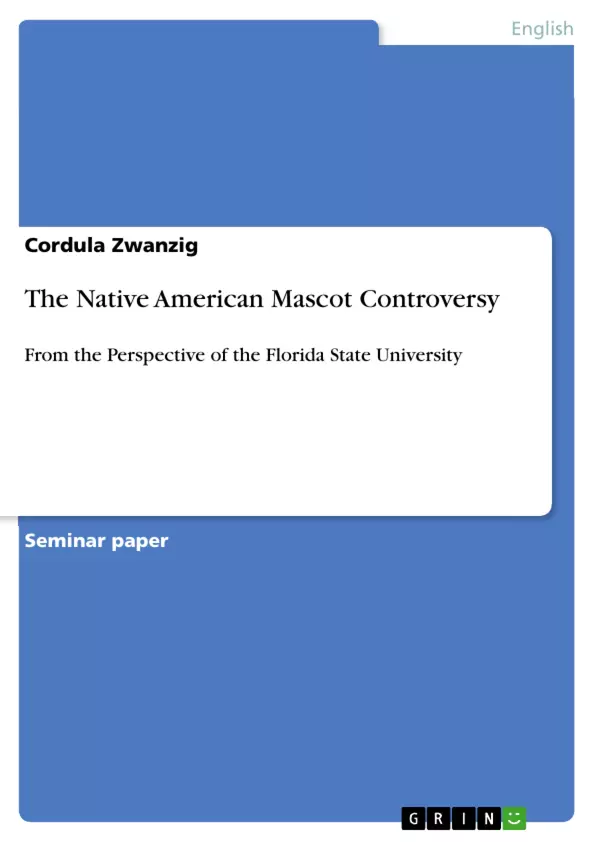This essay tries to explain the justification of this imagery, especially with respect to the recent decision of the National Collegiate Athletic Association (NCAA) to accept the usage of the Seminoles as the dominating theme of all university gear. An insight into the peculiar position of the Seminoles as given by their history in Florida will help to understand not only the current acceptance of the symbolism but mainly the development of the perception of their culture. However, the essay can because of its length and subject focus mainly provide historical background understanding while the main features of the cultural discussion about the moral tenability will only be outlined.
Table of Contents
- Introduction
- Seminole Ethnogenese and First Encounters With the European Settlers
- The Way Towards the Seminole Wars
- Realignment during the Nineteenth and Twentieth Cenutry
- The Development of Native American Mascots in Sports Teams
- Arguments in the Native American Mascot Controversy and their relevance for the FSU
- Conclusion
Objectives and Key Themes
This essay aims to analyze the justification for removing Florida State University from the National Collegiate Athletic Association's "Hostile" or "Abusive" list for its use of the Seminoles as a mascot. The essay explores the historical development of the Seminole tribe, particularly their unique journey and struggles compared to other Native American groups. It investigates the emergence of Native American mascots in sports and the subsequent controversy, focusing on the specific case of FSU.
- The history and formation of the Seminole tribe in Florida
- The cultural and historical context surrounding the Seminole Wars
- The development of Native American mascots in sports and the FSU's use of the Seminole imagery
- The arguments surrounding the Native American mascot controversy
- The justification for removing FSU from the NCAA's "Hostile" or "Abusive" list
Chapter Summaries
The introduction sets the stage for the essay by presenting a thought-provoking scenario comparing the use of Native American mascots to a hypothetical situation involving offensive imagery of Jewish people. This sets the context for the essay's central question: How can FSU's use of the Seminole mascot be justified? The chapter also highlights the essay's scope and limitations, focusing on historical context and providing an overview of the Seminole tribe's development and struggles.
The second chapter, "Seminole Ethnogenese and First Encounters with the European Settlers," examines the unique origins of the Seminole tribe, tracing their roots to the Creek Confederation in present-day Georgia and Alabama. It analyzes the reasons behind the migration of the Seminoles to Florida, exploring the complex and changing interactions between Native Americans and European settlers. This chapter uses Urs Bitterli's model of cultural encounters to analyze the dynamics of the first encounters between the two groups.
The third chapter, "The Way Towards the Seminole Wars," delves into the historical context leading to the Seminole Wars, a series of conflicts between the Seminole tribe and the United States government. This chapter sheds light on the political, social, and economic factors that contributed to the tensions and ultimately led to these conflicts. It explores the Seminole tribe's resilience and resistance against the encroaching expansion of American power.
The fourth chapter, "Realignment during the Nineteenth and Twentieth Century," continues to examine the Seminole tribe's history and their evolving relationship with the United States. It explores the impact of these conflicts and the broader historical trends on the Seminoles' social and cultural landscape. This chapter highlights the Seminole tribe's unique path and its struggle for recognition and self-determination in a rapidly changing world.
The fifth chapter, "The Development of Native American Mascots in Sports Teams," introduces the broader context of Native American mascots in sports teams. It explores the historical roots of this phenomenon and examines the various arguments surrounding the use of Native American imagery in sporting contexts.
The sixth chapter, "Arguments in the Native American Mascot Controversy and their Relevance for the FSU," delves into the specific arguments related to the Native American mascot controversy, specifically focusing on the case of Florida State University. It analyzes the various perspectives and arguments presented by both supporters and critics of the Seminole mascot, providing insight into the complex ethical and cultural considerations surrounding this issue.
The seventh chapter, "Conclusion," offers the author's final analysis and conclusions regarding the justification for removing Florida State University from the NCAA's "Hostile" or "Abusive" list. It synthesizes the historical and cultural insights presented throughout the essay and provides a comprehensive response to the central question posed in the introduction.
Keywords
This essay explores the Seminole tribe's history, the development of Native American mascots in sports, and the controversy surrounding FSU's use of the Seminole imagery. Key themes include Seminole ethnogenese, Seminole Wars, cultural encounters, the Native American mascot controversy, and the justifications for removing FSU from the NCAA's "Hostile" or "Abusive" list.
- Quote paper
- Cordula Zwanzig (Author), 2013, The Native American Mascot Controversy, Munich, GRIN Verlag, https://www.grin.com/document/268136



